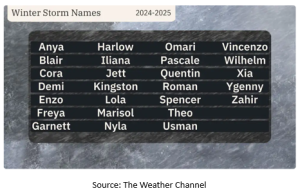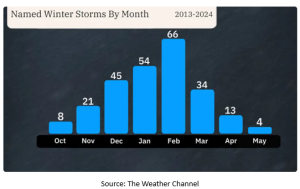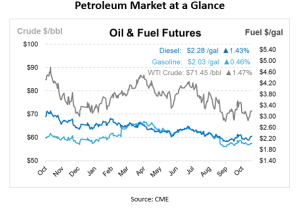
Winter Storms: Names, History, and Patterns
Winter storms can be a major topic of conversation this time of year, especially as we anticipate their arrival. The Weather Channel names storms for both regional and national scale events, and their naming helps raise awareness about the potential hazards they bring.
The practice of naming winter storms is similar to the naming of tropical storms and hurricanes, which began in the mid-20th century. The goal is to enhance public awareness of the dangers posed by these storms. Significant winter storms, especially those that bring heavy snow and ice, can lead to treacherous driving conditions, power outages, and tree damage.
The Current Naming System
Last winter, we witnessed 20 named storms from October through April, starting with Archer and Bryson and concluding with Tormund in early April. This year, the first storm of the season is set to be named Anya. You can learn more about winter 2024/25 forecast here.

While naming these storms helps alert the public, it’s important to note that not every winter weather event is named. For example, lake-effect snowstorms and pure Arctic cold outbreaks do not receive names. Additionally, names that are currently used for hurricanes in the Atlantic and eastern Pacific are excluded from winter storm naming for the next six years, along with any retired hurricane names associated with particularly deadly events.
Historical Trends and Patterns
Historically, the number of named winter storms has shown some consistency. The count has typically ranged from a maximum of 26 storms during the 2013-14 season to a minimum of 19 storms in the 2019-20 season, which was marked by a lack of snow and cold in the Northeast and Midwest. Last season’s 20 storms followed this trend, indicating that while weather patterns can vary, the occurrence of named storms remains fairly stable.
Interestingly, the timing of these storms can also vary significantly. While the first named storm can occur as early as October, November is the most common month for this to happen. Over the last 12 seasons, the average first named storm has been identified by the second week of November, with notable exceptions in recent years, including two storms forming in October in 2019, 2020, and 2023.

February has been identified as the peak month for named winter storms, with the most frequent occurrences between late January and February. As we move into March, the number of storms typically decreases as warmer air begins to infiltrate from the south, reducing the areas susceptible to heavy snowfall.
Looking Ahead
If you’re a fleet manager, how do you get ahead of winter storms?
Mansfield offers extensive coverage and has a proven track record of delivering effective solutions for businesses facing winter fueling challenges. By working closely with Mansfield, you can benefit from our industry expertise, cutting-edge additives like ColdPro, and a commitment to delivering the solutions you need to keep your operations running smoothly during even the harshest winter conditions. With Mansfield, you can navigate the complexities of winter-fueling with confidence and peace of mind.
Contact a cold-weather fueling expert or emergency fuel strategist to test your approach and future-proof your fuel operations.

This article is part of Daily Market News & Insights
Tagged: 2024, 2025, Storm Season, winter
MARKET CONDITION REPORT - DISCLAIMER
The information contained herein is derived from sources believed to be reliable; however, this information is not guaranteed as to its accuracy or completeness. Furthermore, no responsibility is assumed for use of this material and no express or implied warranties or guarantees are made. This material and any view or comment expressed herein are provided for informational purposes only and should not be construed in any way as an inducement or recommendation to buy or sell products, commodity futures or options contracts.





